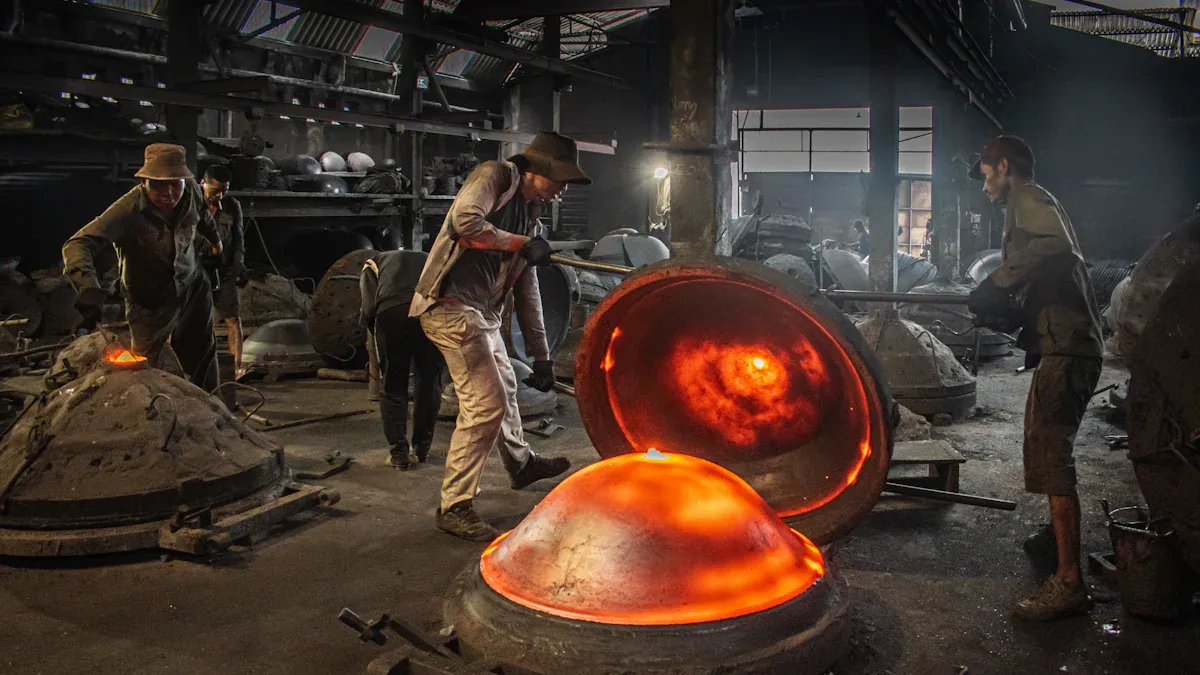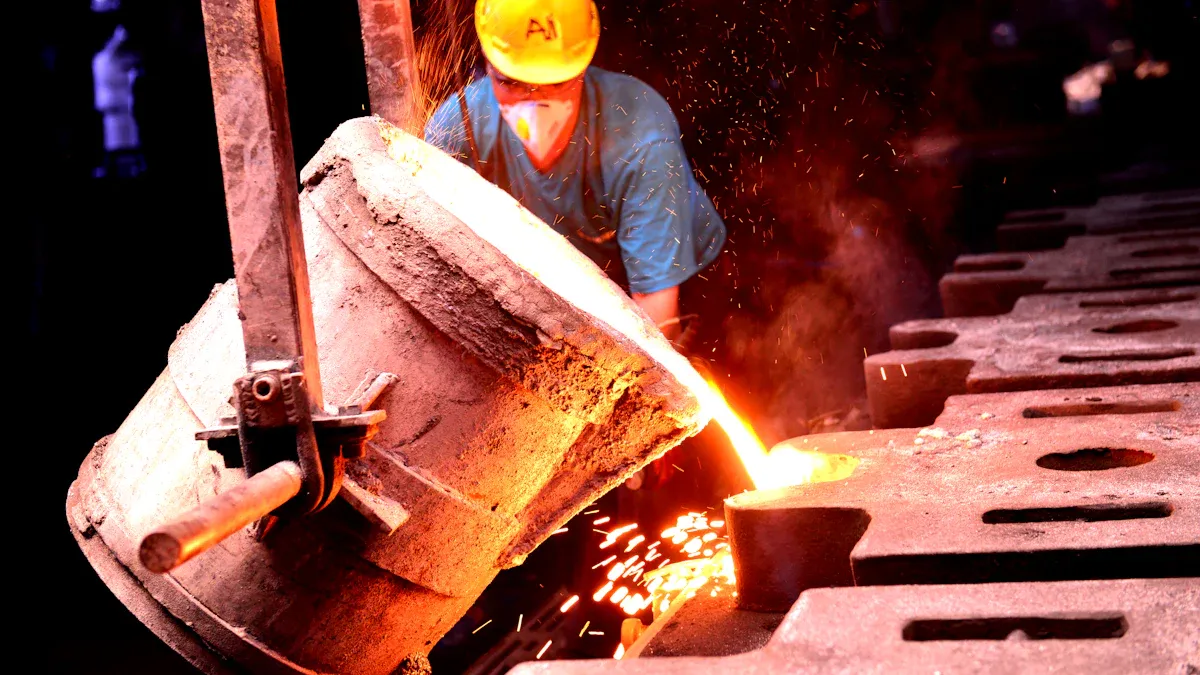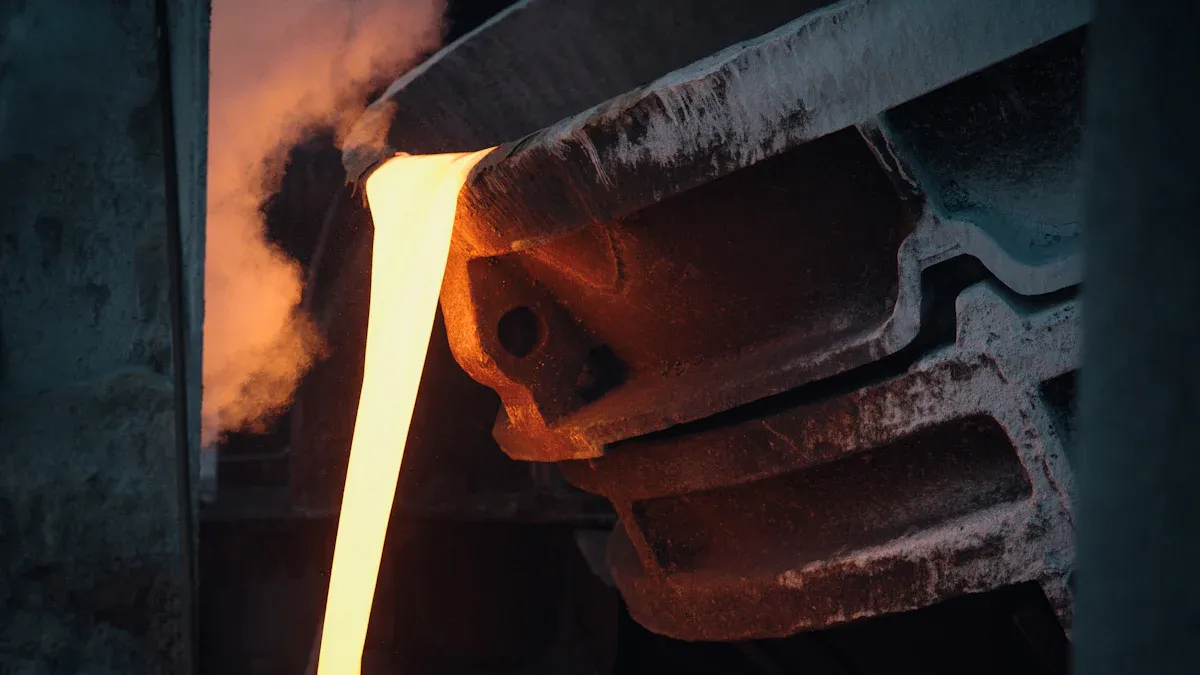
The Metal Die Casting process allows you to create precise and durable metal parts. It uses molds to shape molten metal into complex designs with excellent accuracy. You’ll find this method invaluable for high-volume production where consistency matters. Industries like automotive, aerospace, and electronics rely on it to manufacture components that meet strict quality standards. If you’re searching for “Die Casting Companies Near Me,” understanding this process will help you assess their capabilities.
Key Takeaways
- Metal Die Casting makes strong, exact parts using molds. It works well for making many items quickly.
- Pick hot chamber or cold chamber methods based on the metal’s melting point and project needs.
- This process saves money by using less material and lowering labor costs, especially for big productions.
- Die casting allows creative designs with detailed shapes and different materials to fit specific needs.
- Industries like cars, planes, and electronics use die casting for its accuracy and dependability in making top-quality parts.
Understanding the Metal Die Casting Process
What is the metal die casting process?
The Metal Die Casting process is a manufacturing method that uses molds to shape molten metal into specific forms. You start by preparing a mold, which acts as a blueprint for the final product. Then, molten metal is injected into the mold under high pressure. This ensures the metal fills every detail of the mold, creating parts with excellent precision. After cooling, the solidified metal takes on the shape of the mold, resulting in durable and accurate components.
This process is ideal for producing large quantities of identical parts. It’s widely used in industries where precision and consistency are critical, such as automotive and aerospace.
Types of metal die casting: Hot chamber vs. cold chamber
You’ll find two main types of Metal Die Casting processes: hot chamber and cold chamber. Each type is suited for specific materials and applications.
- Hot Chamber Die Casting:
This method works best with metals that have low melting points, like zinc and magnesium. The machine’s chamber is immersed in the molten metal, allowing quick and efficient injection into the mold. You’ll often see this type used for smaller parts that require high precision. - Cold Chamber Die Casting:
This method is designed for metals with higher melting points, such as aluminum and copper alloys. The molten metal is poured into a separate chamber before being injected into the mold. While it takes slightly longer than the hot chamber method, it’s ideal for materials that can’t be exposed to the machine’s heat for extended periods.
Choosing between these methods depends on the material you’re working with and the specific requirements of your project.
Common materials used in the metal die casting process
The Metal Die Casting process uses a variety of metals, each offering unique properties. Here are some of the most common materials:
- Aluminum: Lightweight and strong, aluminum is perfect for applications requiring durability without added weight. You’ll often see it used in automotive and aerospace industries.
- Zinc: Known for its excellent fluidity, zinc is ideal for creating intricate designs. It’s also highly resistant to corrosion, making it a popular choice for consumer goods.
- Magnesium: This metal is even lighter than aluminum and offers good strength. It’s commonly used in electronics and aerospace applications.
- Copper Alloys: These materials provide excellent thermal and electrical conductivity. They’re often used in industrial equipment and electronics.
Each material brings its own advantages, allowing you to tailor the process to meet specific needs.
Step-by-Step Breakdown of the Metal Die Casting Process

Step 1: Preparing the mold
The first step in the Metal Die Casting process involves getting the mold ready. You’ll start by designing the mold to match the exact specifications of the part you want to create. This mold, often made from hardened steel, serves as the blueprint for your final product.
Once the design is complete, the mold undergoes cleaning and coating. A special lubricant is applied to the mold’s surface to prevent the molten metal from sticking. This lubricant also helps regulate the mold’s temperature during casting.
Tip: Proper mold preparation ensures smooth casting and reduces defects in the final product. Always double-check the mold for any imperfections before proceeding.
Step 2: Melting the metal
Next, you’ll melt the metal that will be used for casting. The choice of metal depends on the requirements of your project. Common options include aluminum, zinc, and magnesium.
The metal is heated in a furnace until it reaches its melting point. For example, aluminum melts at approximately 1,220°F (660°C). Once the metal becomes liquid, it’s ready for the next step.
Note: Maintaining the correct temperature is crucial. Overheating can degrade the metal’s properties, while underheating may result in incomplete filling of the mold.
Step 3: Injecting molten metal into the mold
After melting the metal, you’ll inject it into the prepared mold. This step uses high-pressure machinery to ensure the molten metal fills every detail of the mold.
- Hot Chamber Method: If you’re working with metals like zinc or magnesium, the injection system is immersed directly in the molten metal. This allows for faster and more efficient casting.
- Cold Chamber Method: For metals like aluminum, the molten metal is poured into a separate chamber before injection. This method prevents the metal from being exposed to excessive heat during the process.
Once the mold is filled, the metal begins to cool and solidify, taking on the mold’s shape.
Emoji Insight: Precision is key during this step. Proper injection ensures the final product matches the mold’s intricate design.
Step 4: Cooling and solidification.
Once the molten metal fills the mold, cooling begins. This step allows the metal to solidify and take on the mold’s shape. You’ll notice that cooling is a critical phase in the Metal Die Casting process because it directly impacts the quality of the final product.
The cooling time depends on the type of metal used and the size of the casting. For example, aluminum cools faster than copper alloys due to its lower density. As the metal cools, it contracts slightly, which helps it detach from the mold.
Tip: Monitor the cooling process closely. Uneven cooling can lead to defects like warping or cracks. Using temperature control systems ensures consistent cooling and better results.
Some advanced setups use water or air cooling systems to speed up the process. These systems regulate the mold’s temperature and prevent overheating, which can damage the mold or affect the casting’s precision.
Step 5: Removing the casting and finishing.
After the metal solidifies, you’ll remove the casting from the mold. This step requires care to avoid damaging the newly formed part. Machines or manual tools are often used to eject the casting from the mold.
Once removed, the casting undergoes finishing to enhance its appearance and functionality. You’ll start by trimming excess material, known as flash, which forms around the edges during injection. This step ensures the part matches the desired dimensions.
Next, surface treatments like polishing or coating improve the casting’s durability and aesthetic appeal. For example, aluminum castings often receive anodizing to increase corrosion resistance.
Emoji Insight: Precision trimming and finishing ensure the casting meets industry standards.
In some cases, additional machining may be required to achieve specific features or tolerances. This step is common for parts used in high-performance applications, such as aerospace or automotive components.
Note: Proper finishing not only improves the part’s appearance but also ensures it performs reliably in its intended application.
Key Benefits of the Metal Die Casting Process
High precision and consistency
The Metal Die Casting process delivers unmatched precision. You can produce parts with intricate details and tight tolerances, ensuring every piece meets exact specifications. This consistency is vital for industries like automotive and aerospace, where even minor deviations can impact performance.
The high-pressure injection method ensures the molten metal fills every corner of the mold. This eliminates gaps or imperfections, resulting in flawless components. You’ll find this level of accuracy especially useful when creating parts that require complex geometries or smooth surfaces.
Tip: Precision reduces the need for post-production adjustments, saving you time and resources.
Cost-effectiveness for large-scale production
Die casting offers a cost-effective solution for high-volume manufacturing. Once the mold is prepared, you can produce thousands of identical parts quickly and efficiently. This reduces labor costs and minimizes material waste.
The process also supports automation, allowing you to streamline production and lower operational expenses. You’ll notice that the initial investment in mold creation pays off over time, especially for large-scale projects.
- Advantages of cost-effectiveness:
- Reduced material waste.
- Faster production cycles.
- Lower labor requirements.
Emoji Insight: Cost savings make die casting ideal for industries with high demand for identical parts.
Durability and strength of finished parts
Die-cast components are known for their durability. The process creates parts with excellent structural integrity, making them resistant to wear and tear. You can rely on these parts for applications that require strength, such as engine components or industrial equipment.
The cooling phase of the Metal Die Casting process enhances the metal’s properties. It ensures the final product is dense and free from internal voids, which could weaken the structure. This durability extends the lifespan of the parts, reducing the need for frequent replacements.
Note: Strong and durable parts improve reliability in critical applications, boosting overall performance.
Versatility in design and material options.
The metal die casting process gives you incredible flexibility when it comes to design and material choices. This versatility makes it a go-to method for creating parts that meet specific needs across various industries.
You can achieve complex shapes and intricate details with die casting. The high-pressure injection process ensures that even the smallest features are accurately replicated. Whether you need thin walls, sharp edges, or smooth surfaces, die casting delivers. This precision allows you to design parts that are both functional and visually appealing.
Tip: Use die casting to create parts with unique geometries that would be difficult or impossible to achieve with other manufacturing methods.
When it comes to materials, die casting offers a wide range of options. Each material brings unique properties, allowing you to tailor your choice based on the application. For example:
- Aluminum: Ideal for lightweight and strong components.
- Zinc: Perfect for intricate designs due to its excellent fluidity.
- Magnesium: A great choice for lightweight parts in electronics.
- Copper Alloys: Excellent for applications requiring high conductivity.
This variety ensures you can select the best material for your project without compromising on performance or cost.
Emoji Insight: Think of die casting as your creative toolbox, offering endless possibilities in design and material selection.
The ability to combine design freedom with material versatility makes die casting a powerful solution. You can create parts that not only meet functional requirements but also stand out in terms of quality and innovation.
Applications of the Metal Die Casting Process in Industries

Automotive: Engine components, transmission parts, and structural elements
The automotive industry relies heavily on the Metal Die Casting process to produce high-quality components. You’ll find this method ideal for creating engine parts, transmission housings, and structural elements. These parts need to withstand extreme conditions, including heat, pressure, and vibration.
Die casting ensures precision and durability, which are critical for automotive applications. For example, aluminum die-cast engine blocks offer lightweight strength, improving fuel efficiency. Zinc components, on the other hand, provide excellent corrosion resistance, making them perfect for exterior trims.
Tip: If you’re designing automotive parts, consider die casting for its ability to deliver consistent results and meet strict industry standards.
Aerospace: Lightweight and durable parts for aircraft
In aerospace, weight reduction is key to improving performance and fuel efficiency. The Metal Die Casting process excels at producing lightweight yet durable components for aircraft. You’ll see magnesium and aluminum used frequently in this industry due to their low density and high strength.
Die-cast parts like brackets, housings, and structural supports play a vital role in aircraft design. These components must meet stringent safety and reliability requirements. The precision of die casting ensures that every part fits perfectly, reducing assembly time and enhancing overall performance.
Emoji Insight: Die casting helps you create parts that keep aircraft light and efficient without compromising safety.
Electronics: Housings, connectors, and heat sinks
Electronics demand parts that are both functional and compact. The Metal Die Casting process allows you to create intricate designs, making it ideal for electronic components like housings, connectors, and heat sinks.
Zinc and aluminum are popular choices for electronics due to their excellent thermal conductivity. Heat sinks made from die-cast aluminum help dissipate heat efficiently, ensuring devices operate smoothly. Die casting also enables the production of durable housings that protect sensitive components from external damage.
Note: When designing electronic parts, die casting offers the precision and material options you need to meet performance and aesthetic goals.
Consumer goods: Handles, frames, and decorative items.
You’ll find the metal die casting process invaluable for creating consumer goods that combine functionality with aesthetic appeal. This method allows you to produce items like handles, frames, and decorative pieces with intricate designs and smooth finishes.
Die casting ensures that these products meet high standards of durability and precision. For example, zinc is often used for decorative items due to its excellent fluidity, which captures fine details. Aluminum, on the other hand, is perfect for lightweight yet sturdy frames.
Tip: If you’re designing consumer goods, consider die casting for its ability to replicate complex patterns and deliver a polished look.
Here’s why die casting is ideal for consumer goods:
- Design flexibility: You can create unique shapes and textures that stand out.
- Cost efficiency: High-volume production reduces manufacturing costs.
- Durability: Die-cast items resist wear and maintain their appearance over time.
Whether you’re crafting a sleek door handle or an ornate picture frame, die casting offers the precision and versatility you need.
Emoji Insight: Die casting turns your creative ideas into tangible, high-quality products.
Industrial equipment: Pumps, valves, and housings.
In industrial settings, reliability is non-negotiable. The metal die casting process helps you manufacture robust components like pumps, valves, and housings that perform under demanding conditions.
Die casting produces parts with excellent dimensional accuracy, ensuring a perfect fit during assembly. For instance, aluminum and copper alloys are commonly used for industrial equipment due to their strength and resistance to corrosion. These materials ensure that your components can handle high pressures and harsh environments.
Note: Precision in manufacturing reduces the risk of leaks or malfunctions, which is critical for industrial applications.
Key advantages of die casting for industrial equipment include:
- Strength: Die-cast parts withstand heavy loads and extreme conditions.
- Consistency: Every piece meets exact specifications, ensuring reliability.
- Efficiency: The process supports large-scale production with minimal waste.
Whether you’re producing a pump housing or a valve body, die casting delivers the durability and precision your equipment demands.
Emoji Insight: Dependable die-cast components keep your industrial systems running smoothly.
The Metal Die Casting process simplifies manufacturing by creating precise and durable parts. You follow clear steps, from mold preparation to finishing, ensuring consistent results. This process offers unmatched benefits, including high precision, cost-effectiveness, and design versatility.
You’ll notice its impact across industries like automotive, aerospace, and electronics. By enabling efficient production and innovative designs, it drives progress and meets the demands of modern technology.
Tip: Understanding this process helps you choose the right solutions for your projects and stay ahead in competitive industries.
FAQ
What is the difference between die casting and other metal casting methods?
Die casting uses high-pressure injection to fill molds, ensuring precision and consistency. Other methods, like sand casting, rely on gravity or manual pouring, which can result in less accurate parts. Die casting is ideal for high-volume production of intricate designs.
Tip: Choose die casting for projects requiring tight tolerances and smooth finishes.
Can you reuse molds in the die casting process?
Yes, molds in die casting are reusable. They are made from hardened steel, which withstands repeated use. Proper maintenance ensures molds last for thousands of cycles, making them cost-effective for large-scale production.
Emoji Insight: Reusable molds save time and reduce manufacturing costs.
Is die casting suitable for small-scale production?
Die casting works best for high-volume manufacturing. The initial cost of mold creation can be high, making it less economical for small-scale projects. For smaller runs, consider alternative methods like sand or investment casting.
Note: Evaluate production needs before choosing die casting.
What metals are not suitable for die casting?
Metals with extremely high melting points, like steel and titanium, are not suitable for die casting. These require specialized processes due to their heat resistance. Die casting works best with aluminum, zinc, magnesium, and copper alloys.
Tip: Match the metal to your project’s requirements for optimal results.
How does die casting ensure part durability?
Die casting creates dense, void-free parts by injecting molten metal under high pressure. This process enhances structural integrity and ensures components resist wear and tear. Cooling and solidification further strengthen the metal.
Emoji Insight: Durable die-cast parts perform reliably in demanding applications.
Post time: Jun-10-2025
